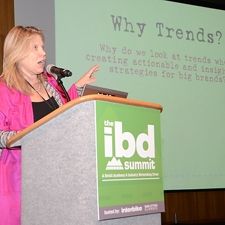MONTEREY, CA (BRAIN)—Retailers must become trend spotters to identify the driving forces behind today’s business and to plan for long-term success. That was the message Marian Salzman drove home with retailers at the inaugural IBD Summit in this seaside town.
Salzman, a renowned trend spotter and social marketing guru, kicked off the retail training conference Wednesday morning by urging business owners to use Twitter to track companies, people, social momentum, economies, brands and radical breakthroughs. “You have to have an insatiable curiosity. But you also have to understand the context. Nothing happens in isolation,” she added.
According to Salzman, digital trends and technology are reshaping every industry. “There is no escape. Even my dry cleaner is a social media driven business,” she said, adding that her cleaner will send a text when her clothes are ready to pick up and allow her to pay with PayPal.
While we live in an IT-obsessed time, social and economic conditions are perfect for bicycle retail, Salzman claimed. In a one-and-a-half hour keynote speech, she rattled off 10 trends that bicycle retailers should be watchful of now and into the future:
1. Health and wellness challenge: “We spend more money on health care than any other country in the world,” Salzman said. The trend toward obesity presents an opportunity. Retailers need to create ways to encourage customers to ride more and focus on the positive health benefits that the bicycle provides.
2. Anxious parenting: Parents realize their kids spend too much time indoors in front of screens—whether it’s a TV, computer, iPad or phone—and don’t get much physical activity. The opportunity is in finding answers for parents’ safety concerns around biking. At Bear Creek Elementary School, for example, walking and biking to school has increased from 25 to 70 percent after parents engaged in a car-free commute program.
3. Eco awareness: According to Salzman, trucks and SUVs won’t be the mainstay of highways. Americans are showing signs of eco awareness as “smart commuting” takes off. Retailers need to make connections with eco-minded individuals and groups to explore partnerships and initiatives.
4. Bikes are really good for real estate: Sagging property prices and negative equity have weighed on Americans minds and realtors in Delaware, Pittsburgh, North Carolina and Vancouver are realizing the added value of marketing bike paths and lanes. The industry needs to work to make the case with local developers and authorities to make communities bike friendly.
5. Value vs. valuable: While there’s been a proliferation of websites that allow consumers to find the cheapest product out there, price doesn’t mean best value. Consumers are yearning for things that are valuable. Think Apple. “Consumers are looking for products that are well designed,” she said. That goes for service, too. For retailers, that means becoming a destination for learning and being part of a community, not just a place to make purchases, Salzman said.
6. Curation to tackle overload: Most people today can’t handle the growing tidal wave of information given their limited time, energy and attention. As a retailer, the opportunity is in curation—the compiling of information and making it easy for people to understand. “You need to really understand what your customer wants because we’re being bombarded with information,” she said. “Figure out who you want as an ideal customer then curate information for them.”
7. News and love of local: Salzman said consumers are increasingly interested in local news. This is reflected in online ad revenue with 40 percent of online ad spending being local in 2010, up from 34 percent in 2009. Websites like Patch are focusing on local/neighborhood news and will post releases submitted by local businesses for free. Retailers should plug in to local media and become the source and hub for cycling.
8. Social media is not going away: First it was Facebook, then Twitter, now it’s Pinterest, an online pinboard that’s fast becoming a new retail tool in what Salzman calls “social shopping.” While usage of this online picture board is strong among women, she predicts it will become crucial to retailers in the future. “It’s the new normal.” For retailers, social media presents a cheap way to market their businesses—no need for marketing or IT specialists.
9. Baby boomers’ new values: This generation has decided to tackle their wrinkles and bulge, according to Salzman. Retailers must make them feel that their store is the place for them. This means training staff and increasing their awareness of servicing older customers that don’t feel old.
10. Digital detox: It’s a digital age and while millions of Americans find their devices to be useful, they also realize they’re addictive. Bikes are ideal for helping people detach from their digital addiction, Salzman argued. Whether it’s casual, shorter group rides, women’s-only rides, retiree-only rides, retailers benefit from targeting groups and devising ways for people to bundle up with one another.


